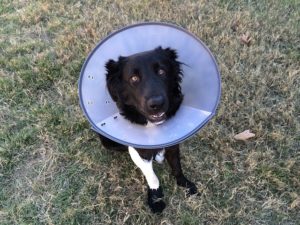
The Elizabethan collar is not the same as the ruff; here’s what it means for cats and dogs.
The Elizabethan collar is the famous “cone of shame” that dogs and cats must wear to heal after surgical treatment or treatment for a wound. Elizabethan collars are not the same as the ruffs that Queen Elizabeth I wore; below is the history of the Elizabethan collar, its uses, and its alternatives.
The History of the Elizabethan Collar
In 1962, Frank L. Johnson invented the first post-surgical pet collar. He called it the Elizabethan collar, or the e-collar for short, after the ruffs worn in the Elizabethan era. His first version was a thin plastic sheet tied around a dog patient’s neck. The goal was to prevent a dog from licking or scratching a wound or surgical site or pulling out stitches. Veterinarians still use plastic or fabric e-collars for cats and dogs post-surgery.
The Elizabethan Collar for Dogs
Elizabethan collars for dogs should fit comfortably around the neck and extend past the snout. You should be able to fit two fingers between the collar and your dog’s neck. If your pet dog is having trouble reaching food and water with the cone on, use raised or shallow feeding bowls or lift the bowl up to your dog. If your dog has trouble balancing, navigating, or performing daily activities, you may need to guide it or find an alternative solution.
The Elizabethan Collar for Cats
The e-collar also is useful for keeping cats from self-mutilating after surgery. Cats are even better at finding ways to scratch or lick the affected area, and the cone successfully prevents them from doing so. Fitting is similar for cats as for dogs; once again, you should use shallow or raised feeding bowls if your cat has difficulty reaching food and water. In both cases, you should clean the collar at least daily or after every feeding session.
Elizabethan Collar Alternatives
Some pets do not handle the Elizabethan collar well. Excess drooling and inability to perform daily activities such as playing and navigating around the house can make life miserable for a pet. If the e-collar does not work, your vet can help you find an alternative, such as a muzzle, visor, inflatable collar, or body wrap. Your pet will heal better and more quickly with the help.
Trust the Care of Your Pet to the Professionals at Everhart Veterinary Medicine!
At Everhart Veterinary Medicine, our veterinary professionals strive to provide your pet with the very best of veterinary care. We believe that the best care for your pet should be provided by experienced, compassionate, and knowledgeable veterinary professionals. With two Maryland locations in both Baltimore and Pasadena, we are always ready to welcome your pet as a new patient! Give us a call today at 410-355-3131 or 410-793-7670! For more information, as well as updates on veterinary news and topics, visit us on Facebook, Twitter, or LinkedIn!
